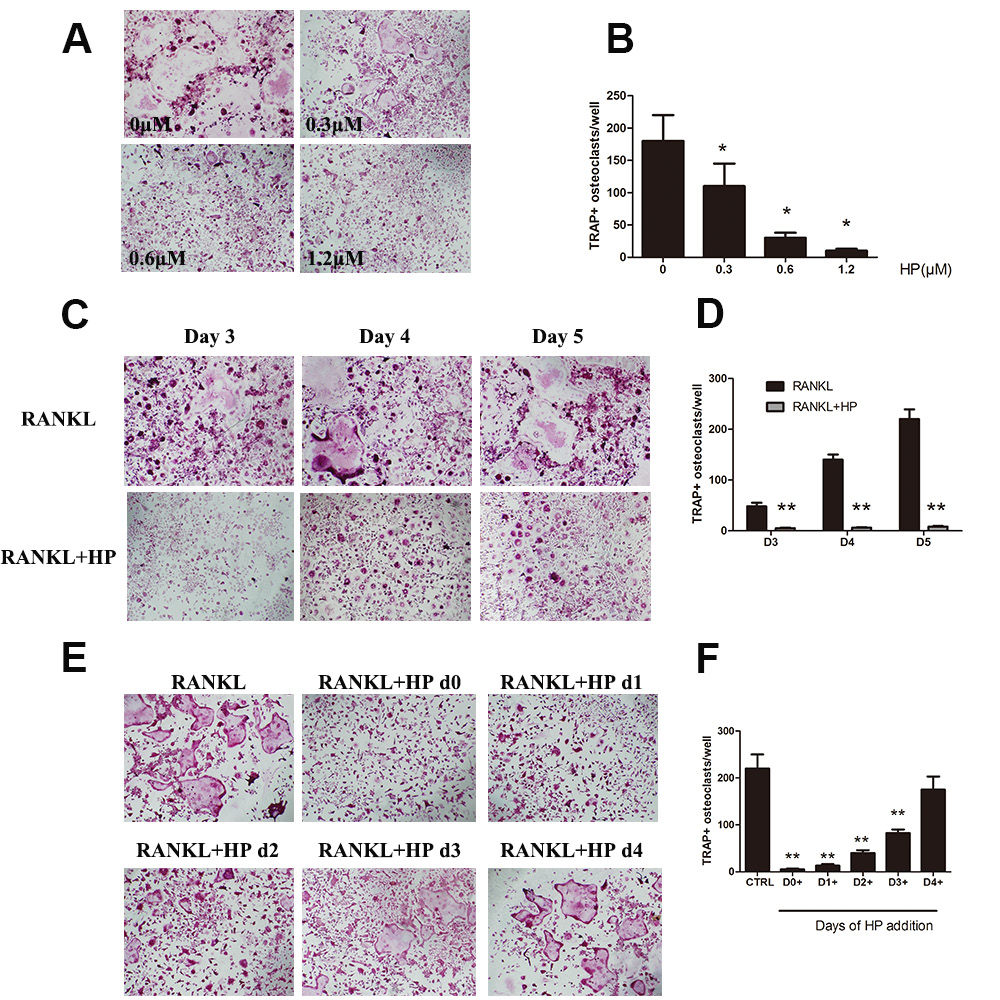Corrections:
Correction: Hypericin targets osteoclast and prevents breast cancer-induced bone metastasis via NFATc1 signaling pathway
Metrics: PDF 2158 views | ?
1 Department of Orthopedics, The Second Xiangya Hospital, Central South University, Changsha, Hunan, P.R. China
2 Department of Orthopedics, Shanghai Ninth People’s Hospital, Shanghai Jiaotong University School of Medicine, Shanghai, P.R. China
3 Department of Orthopedics, The First Affiliated Hospital of Nanchang University, Artificial Joints Engineering and Technology Research Center of Jiangxi Province, Nanchang, Jiangxi, P.R. China
* These authors contributed equally to this work
Published: October 22, 2019
This article has been corrected: Due to errors in image processing, the representative image of TRAP staining in RANKL+HP d1 is incorrect. The proper Figure 1 is shown below. The authors declare that these corrections do not change the results or conclusions of this paper.
Original article: Oncotarget. 2018; 9:1868–1884. DOI: https://doi.org/10.18632/oncotarget.22930.

Figure 1: Hypericin suppresses RANKL-induced osteoclastogenesis. (A) Effects of HP on RANKL-induced osteoclast differentiation. RAW264.7 cells (3 × 103 cells/well) were stimulated with RANKL (50 ng/mL) or were untreated (controls), followed by treatment with the indicated doses of HP. After 5-7 days, cells were fixed and stained for measurement of TRAP expression. The cells were photographed (original magnification, 100×). (B) The TRAP-positive multinucleated (> 3 nuclei) osteoclasts were counted. Columns represent the mean results of experiments carried out in triplicate, whereas bars represent the standard deviation (SD). (C) RAW264.7 cells (3 × 103 cells/well) were incubated in a medium supplemented with either RANKL (50 ng/mL) or RANKL and HP (1.2 μmol/L) for 3, 4, or 5 days and then stained for measurement of TRAP expression to examine osteoclast formation. TRAP-positive cells were photographed (original magnification, 100×). (D) The TRAP-positive multinucleated (> 3 nuclei) osteoclasts were counted. Columns represent the mean results of experiments carried out in triplicate, whereas bars represent the SD. (E) RAW264.7 cells (5 × 103 cells/well) were incubated with RANKL (50 ng/mL), and then HP (1.2 μmol/L) was added on day 0, 1, 2, 3, or 4. After five days, cells were stained for measurement of TRAP expression. The cells were photographed (original magnification, 100×). (F) The TRAP-positive multinucleated osteoclasts were counted. Columns represent the mean results of experiments carried out in triplicate, whereas bars represent the SD.
 All site content, except where otherwise noted, is licensed under a Creative Commons Attribution 4.0 License.
All site content, except where otherwise noted, is licensed under a Creative Commons Attribution 4.0 License.
PII: 27273

